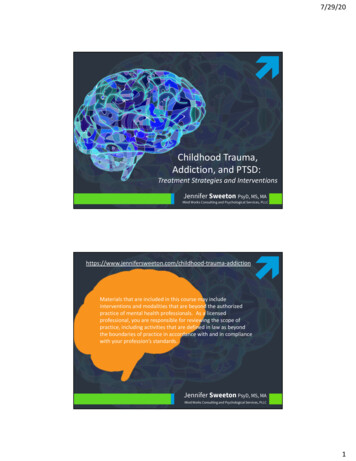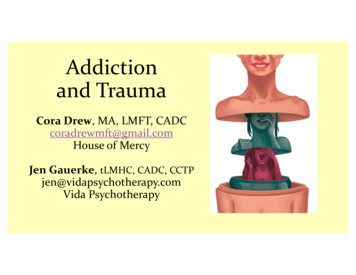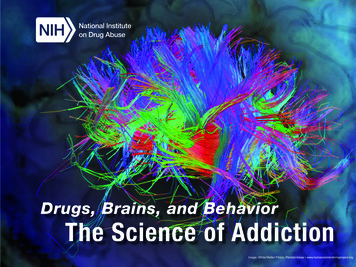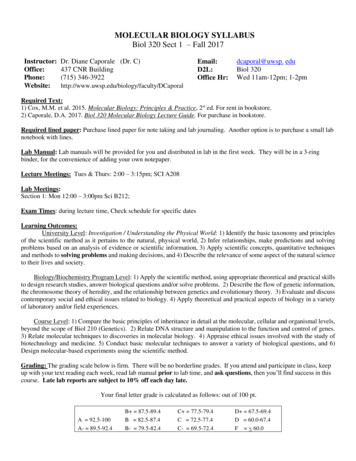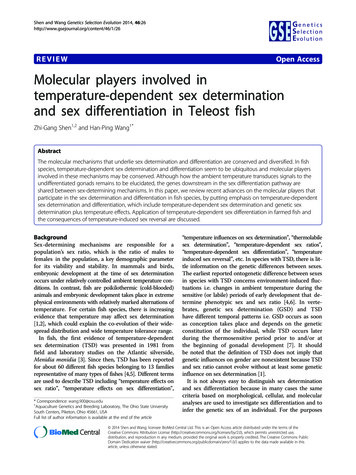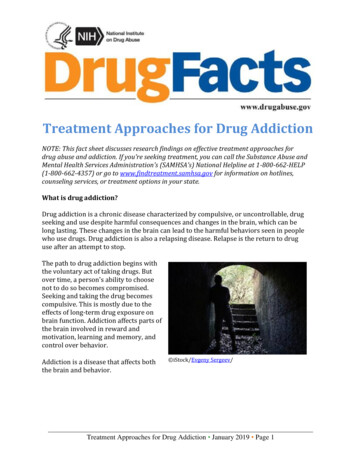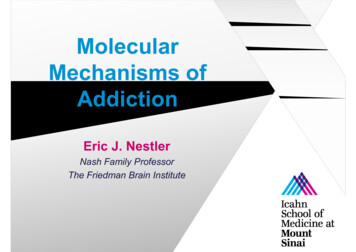
Transcription
MolecularMechanisms ofAddictionEric J. NestlerNash Family ProfessorThe Friedman Brain Institute
Medical Model of Addiction Pathophysiology- To identify changes that drugs produce in avulnerable brain to cause addiction. Individual Risk- To identify specific genes and non-genetic factorsthat determine an individual’s risk for (orresistance to) addiction.- About 50% of the risk for addiction is genetic.Only through an improved understanding of the biologyof addiction will it be possible to develop bettertreatments and eventually cures and preventivemeasures.
Scope of Drug Addiction 25% of the U.S. population has a diagnosis of drugabuse or addiction. 50% of U.S. high school graduates have tried an illegaldrug; use of alcohol and tobacco is more common. 400 billion incurred annually in the U.S. byaddiction:- Loss of life and productivity- Medical consequences(e.g., AIDS, lung cancer, cirrhosis)- Crime and law enforcement
Diverse Chemical SubstancesCause Addiction Opiates (morphine, heroin, oxycontin, vicodin) Cocaine Amphetamine and like drugs (methamphetamine,methylphenidate) MDMA (ecstasy) PCP (phencyclidine or angel dust; also ketamine) Marijuana (cannabinoids) Tobacco (nicotine) Alcohol (ethanol) Sedative/hypnotics (barbiturates, benzodiazepines)
Chemical Structures of SomeDrugs of AbuseCocaineMorphineNicotineEthanol 9-tetrahydrocannabinol
% of US population as weekly usersUse ofDrugs ofAbuse1007550250
Definition of Drug Addiction Loss of control over drug use. Compulsive drug seeking and drug taking despitehorrendous adverse consequences. Increased risk for relapse despite years of abstinence.
Definition of Drug Addiction Tolerance – reduced drug effect after repeated use. Sensitization – increased drug effect after repeated use. Dependence – altered physiological state that leads towithdrawal symptoms upon cessation of drug use.
Definition of Drug Addiction BUT: many non-addictive drugs can cause tolerance,sensitization, or dependence. Therefore, tolerance, sensitization, and dependence donot per se define addiction. Rather, addiction is caused by drug-induced changes inreward or reinforcement. These changes may include tolerance, sensitization, ordependence in reward-reinforcement mechanisms.
What is Reward and Reinforcement?Reward Positive emotional effects.Reinforcement A stimulus that causes a response to be maintainedand increased. Positive reinforcement: increases behavioralresponse to get a positive reward (food, sex, etc.). Negative reinforcement: increases behavioralresponse to end punishment (pain, starvation).In this way, rewards and reinforcements in the environmentpowerfully shape an individual’s behavior.
Animal Models of Drug AddictionHow can one model reward, reinforcement, and addictionin laboratory animals?
Animal Models of Drug Addiction U
Animal Models of Drug AddictionConditioned place preference Animals learn to prefer drug-paired environment.Drug self-administration If left unchecked, a portion of animals overdose.Relapse to drug self-administration Stimulated by drug itself or by drug-associatedcues or stress.Intra-cranial self-stimulation Drugs promote an animal’s choice to electricallystimulate brain reward regions.
Brain Reward RegionsHighly integrated“limbic” circuitsinnervated bydopaminePrefrontalneurons incortexthe VTA.NucleusaccumbensVTAAmygdalaHippocampus
Role of Dopamine in Worms C. elegans (round worms) contain 4-8 dopamine neurons(depending on sex). Worms normally slow down when they encounter food(bacteria). This behavior is lost in worms upon ablation of thesedopamine neurons. Thus, the use of dopamine in a neural circuit that controlsmotor responses to natural rewards goes back 1 billionyears in evolution.
Role of Dopamine in Mammals VTA dopamine neurons are “rheostats” of reward:– Rewards activate the neurons– Expectation of rewards activates the neurons– Absence of expected rewards inhibits the neurons– Unexpected rewards activate the neurons even more. Drugs directly and powerfully activate these neurons with noconnection to purposeful behavior. This leads to a profound corruption of the brain’s rewardmechanisms: drugs gradually, progressively, and insidiouslyreplace natural rewards as the major shaper of behavior.
Role of VTA Dopamine Neurons in HumansThe human VTA is activated by unexpected rewards, less so byexpected rewards, and is inhibited by lack of expected rewards.Effect of monetary rewardson functional MRI (fMRI),which provides a measureof neural activityD’Ardenne et al., 2008UnexpectedrewardExpectedrewardReward expected,not received
Brain Imaging Demonstrates DrugActions on Brain Reward RegionsDrugs of abuse activate the same brain areas that are activatedby natural rewards, only they activate them more strongly.CocaineMorphinefMRI scans show which brainregions are activated in responseto a drug or natural reward.MoneyNucleusaccumbensBreiteret al.,1998
Drugs of Abuse ActInitially at the SynapseDrugs block thedopamine pump: Cocaine AmphetamineDrugs activate orinhibit channels: Alcohol PCP, ketamineDrugs mimic neurotransmittersby activating receptors: Morphine & other opiates Nicotine Marijuana
Convergence of Drugs of Abuse on theVTA-Nucleus Accumbens Reward iatesPCPAlcoholStimulantsGABANicotine)VTANucleus accumbens
Drugs of AbuseAct at the SynapseDrugs block thedopamine pump: Cocaine AmphetamineDrugs activate orinhibit channels: Alcohol PCP, ketamineDrugs mimic neurotransmittersby activating receptors: Morphine Nicotine Marijuana2nd, 3rd, etc.chemicalmessengersLong-lastingchanges
Addiction: Drug-Induced NeuralPlasticity Mediated Via AlteredGene ExpressionReceptorsSecond messengers& ulation of manycellular processesTranscription factorsStable adaptationsin neural functionTarget genes
Examples ofSignalingPathwaysInside of Neurons
Neurobiological Basis of Drug AddictionAddiction is associated with several types of long-lastingabnormalities, induced in brain reward regions by repeatedexposure to drugs of abuse: Reduced responses to natural rewards. Sensitized responses to drugs of abuse and associated cues. Impaired cortical control over more primitive reward pathways.
Neurobiological Basis of Drug AddictionAddiction is associated with several types of long-lastingabnormalities, induced in brain reward regions by repeatedexposure to drugs of abuse: Reduced responses to natural rewards. Sensitized responses to drugs of abuse and associated cues. Impaired cortical control over more primitive reward pathways.
Neurobiology of Drug AddictionControlAddictedDecreasedsize of VTAdopamineneuronsGlutamate inputs fromother limbic regions
Mechanism of ImpairedDopamine Signaling There is increasing evidence in animal models and inhumans that long-term exposure to drugs of abuse impairsdopamine neurons as well as dopamine signaling in thenucleus accumbens. This dampens natural reward and leaves the addict“unrewarded” (amotivational, depressed) without drug.– Example of reward tolerance. This effect is mediated in part by actual physical shrinkageof VTA dopamine neurons in response to chronic drugadministration.
Some Drugs of Abuse Decrease theSize of VTA Dopamine NeuronsChronic drug use causes dopamine cells to shrink in animals,dramatically decreasing reward signals:NormaldopaminenervecellsDopaminenerve cellsfrom amorphineaddicted rat.The sameeffect isseen inhumans.Sklair-Tavron et al., 1996; Russo et al., 2007; Mazei-Robison et al., 2011
Mechanism of Shrinkage ofVTA Dopamine NeuronsDrugs of abuse decrease the size of VTA dopamine neuronsby depriving the neurons of a crucial nerve growth factor,BDNF (brain-derived neurotrophic factor): Chronic drug exposure decreases BDNF signaling in theVTA. Loss of BDNF signaling mediates the decrease in VTA cellsize and impairs reward behavior. Restoration of BDNF signaling prevents the ability of drugexposure to decrease the size of VTA neurons.
Local Knockout of BDNF from VTAMimics Effect of Chronic MorphineBDNF mRNAMazei-Robison et al., 2011Cell surface area (% control)Injection of AAV-Cre into VTA of floxed BDNF mice induceslocalized BDNF knockout and decreases VTA cell size:120100806040200*
The Effect of Chronic Morphine isBlocked by BDNF Infusion into the VTAIntra-VTA injection of BDNF blocks morphine action:BDNF infusionsMorphineCell surface area(% control)Sham120100806040200Sklair-Tavron et al., 1996*
Chronic Morphine Decreases VTA CellSize via Complex Actions on BDNF Signalingneuron’scell membrane
Neurobiology of Drug AddictionControlGlutamate inputs fromother limbic regionsAddictedIncreaseddendriticbranching ofNAc neurons
Addiction: Drug-Induced NeuralPlasticity Mediated Via AlteredGene ExpressionReceptorsSecond messengers& ulation of manycellular processesTranscription factorsStable adaptationsin neural functionTarget genes
Genes ControlBrain Function byDetermining theTypes and Amountsof ChemicalMessengers in theBrainGenes (DNA)( 25,000)Messenger RNAs( 100,000)Proteins( 200,000)Chemical messengers in brainNormal and abnormal brain function
Drugs of AbuseRegulate MasterControl ProteinsMaster controlproteins, ortranscriptionfactors,control theexpressionof other genesGenes (DNA)( 25,000)Messenger RNAs( 100,000)Proteins( 200,000)Chemical messengers in brainNormal and abnormal brain function
FosB: A Molecular Switch for AddictionHigh levels of FosBare induced in NAcuniquely by chronicdrug exposure,creating a molecularswitch.Fos family oftranscription factors:52-58 kD (c-Fos)46-50 kD (FosB)40 kD (?Fra1, Fra2)35-37 kD (modified FosB) FosB inductionthen mediatessensitized drugresponses.Nestler, 200833 kD (unmodified FosB)
FosB Mediates Sensitized Drug ResponsesDrug side minus saline side (sec)Analysis of inducible bitransgenic mice in place conditioning:400* FosB JunDGene off ( dox) FosB on (-dox) JunD on (-dox)( FosB antagonist)*300*200100*0-1007.5157.5These mice express FosB or JunD (ablocker of FosB)selectively in nucleusaccumbens anddorsal striatum.15Cocaine (mg/kg)Kelz et al., 1999; McClung et al., 2003
FosB Sensitizes Drug Responses by Alteringthe Structure of Nucleus Accumbens NeuronsGFP30# spines/10 mmViral expression of FosBin NAc mimics cocaineinduced increases in spinedensity, while JunD blockscocaine action.**2520SalineCocaine*151050GFP FosB JunD FosBMaze et al., 2010
Mining Chromatin and Gene ExpressionData to Understand Structural PlasticityNumerous FosBtargets mediatecocaine-induceddendritic growthCocaine FosBOthersActin regulatory ac1 GEFs,GAPsTranscriptional regulatorsSIRT1NF BG9aRap1ArcMEF2Dnmt3aCDK5Regulation of the actin cytoskeleton andinduction and stabilization of dendritic spinesOthers
Translating Neurobiological KnowledgeInto Better TreatmentsWill it be possible to use our neurobiological understandingof drug addiction at the molecular and cellular levels? All current treatments for drug addiction, which remain verylimited, focus on neurotransmitters and receptors. Studies of BDNF, FosB, and many other signaling cascadessuggest hundreds of potential targets for new medicationtreatments. Validation of new targets is crucial since all medicationsavailable today target perhaps a few hundred of the 100,000sof proteins expressed in the brain.
Questions for DiscussionDoes the current legal status of drugs of abuse make sensegiven our understanding of the neurobiology of addiction?Are all drugs of abuse equally addicting?How much alcohol is it safe to drink?Given that methylphenidate (Ritalin) shares cocaine’smechanism of action, is it a safe medication for attentiondeficit disorder?
Scope of Drug Addiction 25% of the U.S. population has a diagnosis of drug abuse or addiction. 50% of U.S. high school graduates have tried an illegal drug; use of alcohol and tobacco is more common. 400 billion incurred annually in the U.S. by addiction: - Loss of life and productivity - Medical consequences
